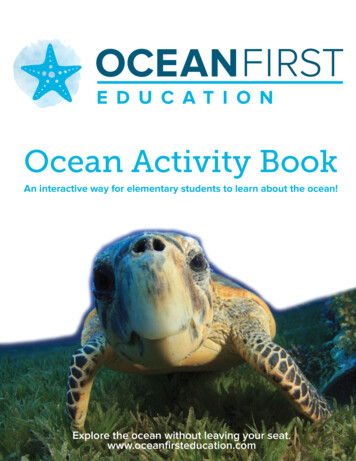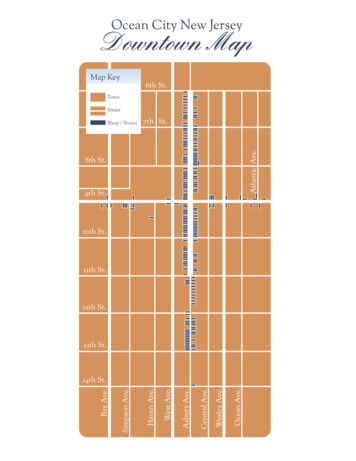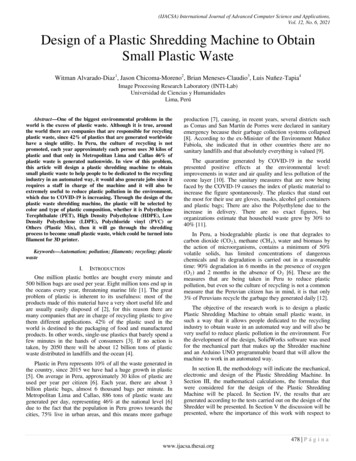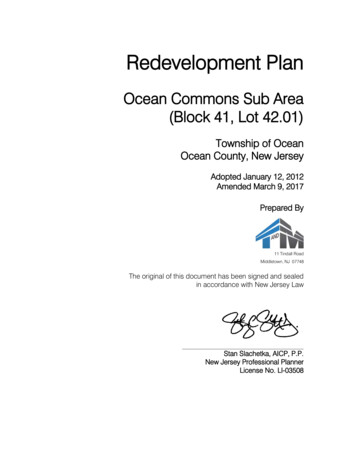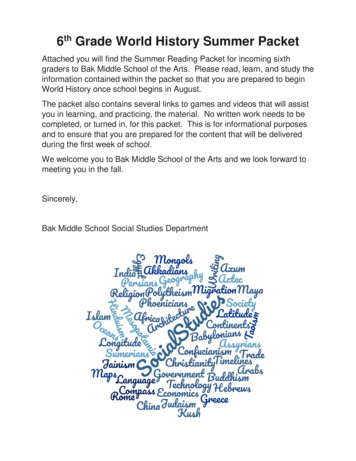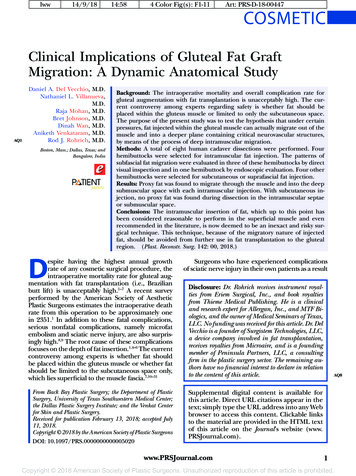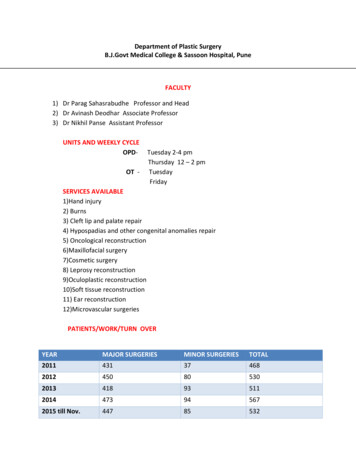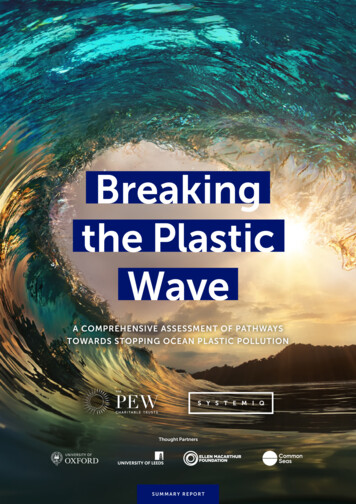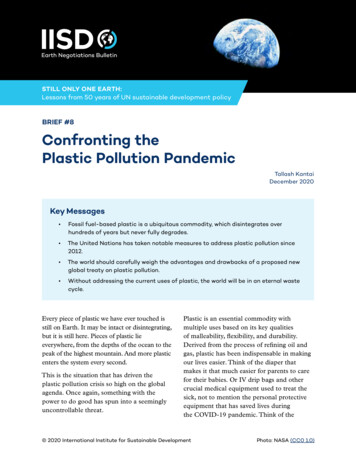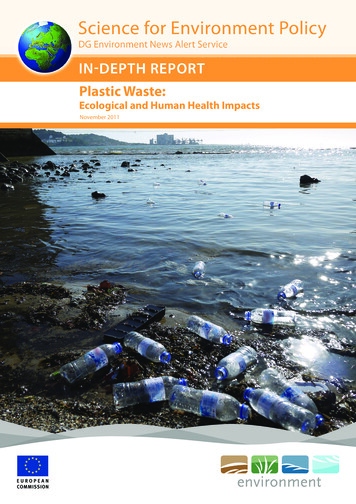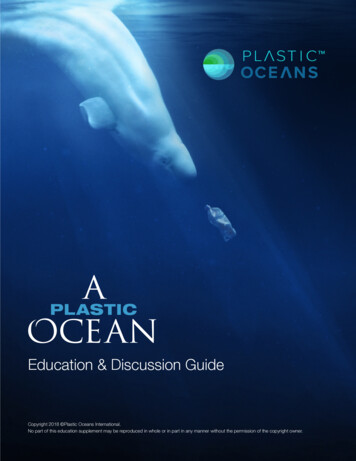
Transcription
Plastic Oceans International1A Plastic Ocean – Education & Discussion GuideTitleEducation & Discussion GuideCopyright 2018 Plastic Oceans International.No part of this education supplement may be reproduced in whole or in part in any manner without the permission of the copyright owner.PlasticOceans.org
Plastic Oceans InternationalA Plastic Ocean – Education & Discussion Guide2Table of Contents2Table of Contents3About this Guide4About the Film5Director’s Q&A7Key Facts15Possible Solutions, Possible Problems20Discussion Questions21Frequently Asked Questions24Activities28Worksheet: Word Search29Worksheet: Crossword30Glossary33Take ActionPlasticOceans.org
Plastic Oceans International3A Plastic Ocean – Education & Discussion GuideAbout This GuideThis companion guide to the film A Plastic Ocean helps educators teach their students to use the infor-mation presented in the documentary to learn about and create potential solutions to our plastic pollutionproblem. This guide is organized to follow along with the topics in the film A Plastic Ocean.How To Use This GuideThis guide offers a variety of activities and resources to help students explore the ideas and problems presented in the film and then consider potential solutions to our plastic problem. This guide was designed tobe used as a whole, or you can select individual activities as you best see fit.This Guide Is Designed For: Students, post-screening A Plastic Ocean Classes, events, or trainings in areas such as: Environmental Science Marine Biology Government and Politics Business and Entrepreneurship Science and Technology Service Learning Social EntrpreneurshipPlasticOceans.org
Plastic Oceans International4A Plastic Ocean – Education & Discussion GuideAbout the FilmScientists Solving a Jigsaw Puzzle . Gyre by GyreIn the center of the Pacific Ocean gyre our researchers found more plastic than plankton. A Plastic Oceandocuments the newest science, proving how plastics, once they enter the oceans, break up into smallparticulates that enter the food chain where they attract toxins like a magnet. These toxins are stored inseafood’s fatty tissues, and are eventually consumed by us.If it was happening in one gyre, they suspected it was happening in all of them. But the filmmakers neededexperts to prove it.Scientists were brought in at each stage to analyze the findings from one part of the story to add their datato the overall report on the five gyres. Producer Jo Ruxton joined an expedition to the so-called Great Pacific Garbage Patchin the North Pacific Gyre, 1500 miles off the coast of San Francisco, to ascertain itsimpact. When the expedition discovered free-floating microplastics instead of ananticipated solid mass that could be contained, Jo knew she had to begin the filmthat would become A Plastic Ocean. Jo had worked for the WWF International in Hong Kong and partnered with director andjournalist Craig Leeson. Their first collaboration was on a documentary about endangeredPink Dolphins in Hong Kong. Jo and Craig brought on Dr. Lindsay Porter, an expert in cetaceans (whales and dolphins). Together they contacted the world’s experts to see what was known about plasticpollution in the gyres. The team expanded to include Dr. Bonnie Monteleone who had already foundmicroplastics in other gyres she had investigated. She joined the expedition tothe South Pacific gyre. With new information emerging about the extent of the issue in each of the Ocean gyres,free diving champion Tanya Streeter joined the team. Together they set off on what wouldbe a four-year global odyssey to explore the issue of plastics in our oceans and its effecton marine ecosystems and human health, including endocrine disruption.PlasticOceans.org
Plastic Oceans International5A Plastic Ocean – Education & Discussion GuideDirector’s Q&A: Craig LeesonWhy did you want to get involved?The creatures that inhabited the sea became a source of intrigue and study, thewaves my playground. From an early age I noticed the severe effects industrial pollutionwas having on the Coastal waters where I grew up and also the effect it was having onme personally.When did you start recognizing plastic as a globalenvironmental issue?In 2010, I became aware of one increasing sourceof pollution, which had until then escaped my notice. Itwas something I’d been told and taught was disposable.Plastic. From that moment, I noticed plastic everywhereand began to study intensely its effects on marine lifeand humans.Why do you think this is such an important issue for theworld to address?Plastic is a man-made substance. It isn’t supposed tobe in the environment and the environment has no wayof dealing with it, so it is building up and poisoning ourearth like a disease. We live in a world where we areusing up those resources faster than is sustainable. Veryfew of us are taught that our oceans keep us alive. AsDr. Sylvia Earle says “without the blue there is no green.”Our weather systems, oxygen, clean water, foodsources, medicines, come from the oceans or aresustained by them.PlasticOceans.org
Plastic Oceans International6A Plastic Ocean – Education & Discussion GuideWhat do you hope to accomplish with the film, A Plastic Ocean?If you do not know, then you cannot care. With knowing comes caring. By raisingthis issue we hope to begin a discourse on the problem that will promote and invokechange. We need to recognize solutions that work and come up with others that solvethe problem of plastic that is already in the environment. Only through the sharing ofinformation on this issue will the public change policy on how we treat plastic.How have you changed since taking on this project?I’ve become more self aware of the impact I’m having on the world around me.Directly, I’ve become a megaphone for campaigning against single-use plastic: I findmyself informing supermarket check-out people, takeaway servers, café owners,bankers, politicians and anyone who will listen about the detrimental impact of singleuse plastic. I have developed a keen interest in green and sustainable financial fundsand businesses where profit is based on sustainability and environmental responsibility.PlasticOceans.org
Plastic Oceans InternationalA Plastic Ocean – Education & Discussion Guide7TitleKey FactsPlasticOceans.org
Plastic Oceans International8A Plastic Ocean – Education & Discussion GuideThe Problem: Plastic is Indestructible.Every item of plastic that has ever been created is still with us onthe planet today. In the mid 50’s we were told that plastic wassuitable for single use and could simply be thrown away. We nowknow that to be untrue yet we continue to treat it as such.Our Plastic UseWE USE20 MILLIONUCEWE PRODONILLIM003YEARPLASTIC WATER BOTTPER DAYIT TAKES3 LITERSRLASTIC PETONS OF PLESOF WATER TO MAKEA 1-LITERPLASTIC BOTTLEOVER8 MILLIONETONS OF PLASTIC ARDUMPED IN OUR OCEANSEVERY YEAR12 MINUTESIS THE AVERALIFETIME OFGE USEFULPLASTICS50%of all plasticIS SINGLE-USEPlasticOceans.org
Plastic Oceans InternationalA Plastic Ocean – Education & Discussion Guide9Beverage Bottles100.7 billion plastic beverage bottles were sold in the U.S. in 2014, or 315bottles per person, according to the Container Recycling Institute.57% of those units were plastic water bottles: 57.3 billionplastic water bottles sold in 2014. This is up from 3.8 billionplastic water bottles sold in 1996.The process of producing bottled water requires around sixtimes as much water per bottle as there is in the container.14% of all litter comes from beverage containers. When capsand labels are considered, the number is higher.PlasticOceans.org
Plastic Oceans International10A Plastic Ocean – Education & Discussion GuidePlasticPlastic is made from oil with acombination of chemical ingredients toform different types of plastics.All plastics are made fromsynthetic polymers.Plastics contain different chemicals thatgive them their unique structure, flexibilityand use.Many of the chemicals used mimic estrogenic activity. This happenswhen a chemical like BPA or phthalate leeches from the plastic andenters the body, mimicking the hormone estrogen.PlasticOceans.org
Plastic Oceans International11A Plastic Ocean – Education & Discussion GuideOur Oceans and Plastic PollutionThere are five main ocean currents, also known as‘gyres’ which are created by the Earth’s rotation andthe resulting predominant winds. These are: North &South Pacific, North & South Atlantic, and Indian.80%20yearsScientists estimate that it takes aboutof ocean waste originates from land.This waste travels to the center ofthe gyre where it collects.for waste to reach the center of the ocean.Plastic waste pieces break up into much smaller bits asthey are eroded by sunlight, salt water, currents and waves.These pieces of plastic have rough, pitted surfaces.More than50% of marine debris, including plastic, will sink.
Plastic Oceans InternationalA Plastic Ocean – Education & Discussion Guide12TitleThe Food Chain and PlasticsThere are two types of plankton: zooplankton (animals) and phytoplankton (plants).Zooplankton feed on phytoplankton, small fish feed on zooplankton, squid feed onsmall fish and so it goes on up the food chain.Water born chemicals, from decades of industry and agriculture attract to plastic likea magnet. When these plastics mix with plankton, they are eaten by fish and becomepart of the food chain. These toxins ‘hitch-hike’ on plastics. Different types of plasticsattract toxins at different rates, making some more potent than others.Once ingested by fish, these toxins are released from the plastic fragments andare carried in the bloodstream and stored in the fatty tissues of the fish. Thesetoxins have been linked with cancer, autoimmune disease, cognitive problems,infertility and endocrine disruption. We then eat these fish, causing the toxins toenter our bodies.60%of the world’s population rely onfish as its main source of protein.PlasticOceans.org
Nurdles:The pre-production raw pellets formed when you turn oilinto plastic. People, animals and birds can confuse them foreggs/food. They are also known as mermaid tears.Nurdles have been found on every single beach scientists havestudied. even on the most remote islands of the planet. Theywere found in every surface trawl made during the filming ofA Plastic Ocean and scientists have evidence that they haveeven made their way to the pristine waters of Antarctica.Micro plastic beads are used in many health care andcleaning products as they are cheaper than pumice or rice.We are flushing these plastics straight into the ocean.Scientists have found that plankton at the base of the foodchain have eaten “micro plastics” such as nurdles.50%The oceans provide more thanof the oxygen we breathe, thanks to thephytoplankton. That’s more than the rainforests!
Plastic Oceans International14A Plastic Ocean – Education & Discussion GuideTitleAnimals and Plastic PollutionThe Blue Whale filmed by the team in Sri Lanka ingests75,000 litersof water every time it opens its mouth. Imagine howmuch plastic it must take in!!OverParent birds will eat what they see that isbright and reflective. Plastic pieces look likefish or squid to the parent birds who feedthese to their young.40%of all sea birds haveingested plastic.The record number of pieces of plastic found inTranslated into human terms, that’s 6-8 kilosone 90-day old seabird chick isof plastic, or the equivalent of276 pieces 15%12 pizzasinside your stomach.of that bird’s body mass.PlasticOceans.org
Plastic Oceans International15A Plastic Ocean – Education & Discussion GuidePossible Solutions,Possible ProblemsLong-Term & Bridge SolutionsOur plastic problems can be addressed with a combination of solutions and all need to be incorporated tobring needed change. Long-term solutions work to remove petrol-plastic and their by-products from theenvironment. Bridge solutions work at removing only some petrol-plastic products, but still leave behindsome plastic product and their negative by-products. However, it is important to note that without thechance of our collective behavior and political will, these solutions will not be enough. Below are possiblesolutions, as well as their advantages and disadvantages.Potential Solutions:A.Rethink PlasticB.RecyclingC.IncincerationD.Thermal Cracking - Molten Metal IncinerationE.ReconfigurationF.PyrolisisG.Re-use Via Deposit SystemH.Biodegradable Plastic ProductsI.Pyrogenesis – www.pyrogenesis.comPlasticOceans.org
Plastic Oceans InternationalA.B.16A Plastic Ocean – Education & Discussion GuideRethink Plastic: For every item offered or chosen, consider an alternative that is not made ofplastic. Do this by: Refuse: Single-use plastics end up in our oceans so ask for alternatives that can be usedagain. Reduce: Is it possible to reduce your plastic footprint by eliminating theamount of plastic products used? Eg: Use foil instead of plastic wrap for food Re-use: If you can’t use an alternative to plastic, make sure you re-use it where possibleand dispose of responsibly. Recycle: If you must purchase plastic, where possible, opt for those that are recyclable toreduce additional material ending up a in landfill.Recycling Advantages Reduces our requirement on virgin plastics, thus reduces our oilconsumption Prevents used plastic from ending up in the environmentDisadvantages Contaminants in food packaging are likely to concentrate overrepeated recycling processes Recycling makes us believe the perception that we can continue ourdependency on disposables. Recycling should be considered a last resort for‘disposable’ plastics after reducing, recovering, redesigning, reusing and replacingTwo Types of Recycling1.Mixed Plastic Recycling (www.gruener-punkt.de) Advantages Most plastics can be recycled including simple household items,buckets, plant pots, garden furniture Relatively cheapDisadvantages Limited use - mixing different colours tends to result in dark grey pellets PVC and Styrenes still need to be separatedPlasticOceans.org
Plastic Oceans International2.Separating Plastics for Recycling C.Advantages Higher value pellets Clear and lighter colors have more uses ‘Closed loop’ recycling is the most sustainable system availableDisadvantages Higher initial investment cost for plant that separates types Plastic should be separated at collection point, which adds considerable cost.This would only work efficiently if the public is willing to separate their plasticwaste. Legislation over food grade plastics places a burden on manufacturersIncineration D.17A Plastic Ocean – Education & Discussion GuideAdvantages Plastic can be converted into energy, including electricity Prevents waste plastics from reaching the environment and raw material (oil) has asecond lifeDisadvantages Poisonous gases are bi-product and must be safely removed from the process Not as sustainable as recycling, a process that can be repeated many times Simple incineration without energy production may prevent material reaching theenvironment, but is costly and inefficientThermal Cracking - Molten Metal Incineration (www.stxmultifeed.com) Advantages Plastic waste generates energy Waste gases can be used in cooling systems – cleaner process Higher efficiency rates that standard incinerationDisadvantage Initial investment is highPlasticOceans.org
Plastic Oceans InternationalE.Reconfiguration – using plastic, without changing with heat, as a raw material for otherproducts – www.affresol.com, www.cynarplc.com Advantage Limited use currently yrolisis - the thermal process using high temperatures to breakdown waste in thePabscence of oxygen. Advantages Thermochemical decomposition of plastic changes its structure to produce oil for fuel Profitable Less dependence on fossil fuels Can be very small scale for individual or company use – www.blest.co.jpDisadvantage G.Plastic is used as a raw material for other products, so there is no need to changeits properties. However, chemicals or other products are added. For example: materialfor building blocks, clothing, cartons etc.Disadvantage F.18A Plastic Ocean – Education & Discussion GuideCould produce harmful gases if not treated correctly to remove theseRe-use via Cash Deposit System Advantages Pricing for drinks in plastic bottles includes deposit paid by consumers – incentive toreturn them Conveniently placed machines at supermarket entrance accepts bottles in exchangefor vouchers, creating incentive for recycling Machines sort bottles into plastic types on site ready for specific recyclingDisadvantages Water has to be potable – may not be option for developing countriesPlasticOceans.org
Plastic Oceans InternationalH.Biodegradable Plastic Products I.19A Plastic Ocean – Education & Discussion GuideAdvantages Will degrade naturally given the right conditions – currently only available incommercial composting plants Could replace many ‘disposable’ plastic products and therefore reduce dependenceon oil reserves Fungi and Algae are being used successfully to produce polymer chains that mayeventually become more ‘degradable’Disadvantages Bioplastics are not necessarily biological, and degradability issues also need to beconsidered. In an aerobic, sunlit environment bioplastics will degrade at a fasterrate - but in oceans and landfill degradation is extremely slow and waste still mustbe dealt with Using disposable items perpetuates the culture that using something once andthrowing it away is acceptable Monoculture is encouraged by this process and available land that could producefood would be reduced Pyrogenesis (or Plasma Gasification) – an extreme thermal process using plasma whichconverts waste into a synthesis gas, primarily made up of organic matter, hydrogen,carbon and oxygen – www.pyrogenesis.com Advantages A process that uses plasma to generate high temperatures which effectivelyvaporizes the waste Pyrogenesis plants are small enough for very low-scale incineration such asonboard vessels at sea Resultant solid residue is extremely small and benign Gases are collected and removed before entering the atmosphere and can berecycled to generate energy needed to power the processDisadvantages It is in no way a self sustaining system There are initial limitations due to an inability to scale up plasma technology to beyond50 tons a day - but now companies are starting to do this on a larger scale High initial investment – best for dealing small-scale waste problems or in addition topyrolysis or recycling plantPlasticOceans.org
Plastic Oceans International20A Plastic Ocean – Education & Discussion GuideDiscussion QuestionsInstructions: When the film finishes, immediately begin a guided discussion. The following are some ques-tions and topics to stimulate a discussion after the film. Please also refer to the Frequently Asked Questions(Page 21) to guide your discussion.1. Where does plastic come from?2. How does plastic get in our oceans?3. What scene from the film most personally affected you? Why?4. What does business and industry need to do to help our plastic pollution problem?5. What does government need to do to help our plastic pollution problem?6. What do we as a society need to do to help reduce our plastic pollution?7. What are some ways we can galvanize our community to solve our plastic pollution problem? (i.e.call representatives, letter writing campaign, Plastic Free Pledges etc.)8. How can we reduce our plastic use on this campus?9. What can we do personally? (Also See Page 21 of the FAQ for Ideas)10. How can we creatively and effectively spread this message?PlasticOceans.org
Plastic Oceans International21A Plastic Ocean – Education & Discussion GuideFrequently AskedQuestionsInstructions: The following are some questions and topics typically brought up after a screening. Pleaseuse this FAQ, along with the provided discussion questions, to guide your post-screening dialogue.Frequently Asked Questions: Problems to Current Solutions Film ProductionSolutions To Current ProblemsQ. What can we do?A. We need to stop using single-use plastic wherever that is possible. Here are some more potential solutions: Go to our website for inspiration and please donate if you can to help us:https://www.plasticoceans.org Bring your own bag to the shops Drink tap water and carry it in your own bottle Don’t buy body scrubs - in many countries those tiny beads are usually made of plastic Choose fruit and vegetables that are not wrapped in plastic Use matches instead of ‘disposable’ lighters or use a re-fillable one Don’t use ‘single-use’ plates, knives, forks etc and wash up after you eat Wherever you can, choose liquid products that can be re-filled rather than bought new Refuse plastic straws in your drinks If you can’t find an alternative to single-use plastic, make sure you recycle it Don’t celebrate with balloon releases, because the chances are that the balloons will land in theocean, choking seabirds, turtles and marine mammals Use crystal deodorants – they last far longer, are more effective and some even come with noplastic packaging at all Use good old-fashioned soap – it works as well as liquid soap and lasts longer Buy butter wrapped in paper instead of in a plastic tubPlasticOceans.org
Plastic Oceans International22A Plastic Ocean – Education & Discussion GuideQ. Is compostable or biodegradable plastic the answer?A. Not yet. They are both options that may have potential in the future and hopefully will be developedfurther. Compostable Plastic - is currently only an alternative if it is separated out from the wastestream, collected separately, and then placed in an industrial composter. Compostable plasticwill not ‘break down’ in the ground. Compostable plastic needs light, oxygen and heat, none ofwhich will be available in a landfill. Until that happens compostable plastic will act like normalplastic and can continue to harm wildlife. Biodegradable Plastic - is in its infancy and there are many unsuitable types on the market. For example: biodegradable plastic bags bound together with vegetable components.Once the vegetable has degraded, small pieces of plastic remain in the environment andcause just as much harm as any other plastic. In addition, these bags often look so much like non-biodegradable plastic, they are neitherseparated nor collected differently. Thus, the bags are likely to end up either in recycling –which will not work - or in a landfill where they still take years to degrade. And, if the bagsdo end up in our oceans, they will still harm wildlife via entanglement and ingestion, due totheir long breakdown time.Q. How can we remove the plastic that is already in the oceans?A. At the moment there is no realistic way to remove all the plastic from the oceans. The oceans are far too big. The majority of the plastic has already sunk to the depths. The plastic in our oceans breaks into tiny fragments that mix with plankton. Removing the plasticwould also mean losing the plankton. This is especially problematic as plankton is the vital baseof the marine food chain. Similarly, the plant element, phytoplankton, provides more than half ofthe Earth’s oxygen supply and absorbs more of our CO2 than our forests. Beach clean-ups can help prevent plastic on the beach reaching the oceans and causing harm.Beach clean-ups also raise awareness, as long as the plastic is sorted and recycled responsibly. Putting booms at river mouths can also help, as long as the collected waste is responsiblydisposed of.In conclusion, stopping plastic at the source is our best solution.PlasticOceans.org
Plastic Oceans International23A Plastic Ocean – Education & Discussion GuideQ. Is it dangerous to eat seafood? Do you eat seafood?A. This is a hard one to answer, as we can’t experiment on humans with toxins. Also, linking a disease ordisorder to a fish that may have been eaten years before is almost impossible. What we do know from published science: the chemicals that are carried by or leach fromplastics have been associated with diseases and disorders in the lab. Currently 25% of fish and 100% of mussels studied contained plastic. Even if this is at alevel where it is not causing harm, we cannot afford to let it become worse.PlasticOceans.org
Plastic Oceans International24A Plastic Ocean – Education & Discussion GuideActivitiesActivity A: Possible Solutions, Possible Problems1. Break the class into small groups. Research and brainstorm possible solutions to our plasticpollution problem for the following: Group # 1: Recycling Group # 2: Incineration Group # 3: Biodegradable plastics Group # 4: Pyrolysis (plastic to diesel)2. 10 Minutes - Come back together as a big group. What are the advantages and disadvantages ofeach possible solution?3. 10 Minutes - How can we share this message and move forward? Possible ideas include:school campaigns, presentations to other classes, letters to papers, beach cleans, lobbying localgovernment, etc.Activity B: Rethinking PlasticInstructions: Read the following aloud to the class: “In order to reduce our plastic use, always consider analternative to a plastic item offered. You can do this with The 4-Rs to Rethinking Plastic: Refuse: single use plastics end up in our oceans, so ask for alternatives that can be used again. Reduce: Is it possible to reduce your plastic footprint by eliminating the amount of plasticproducts used? Re-use: if you can’t use an alternative to plastic, make sure you re-use it where possible anddispose of responsibly. Recycle: If you must purchase plastic, opt for items that are recyclable to reduce additionalmaterial ending up in landfills. From a sustainability perspective, recycling remains one of ourkey solutions. Recycling reduces our requirement on virgin plastics (thereby reducing ourconsumption of oil, as plastic is made from oil) and also prevents used plastic from ending upin the environment.PlasticOceans.org
Plastic Oceans International25A Plastic Ocean – Education & Discussion GuideNow, let’s brainstorm. How can you use the 4-R’s to rethink plastic? For example: Refuse: Say no to single use plastic products, ask for alternatives to single use plastic plates, cutleryor cups when eating out, use bar soap instead of liquid. Reduce: Carry a refillable water bottle, use stainless steel straws, bring reusable shopping bags. Re-use: Refill a plastic water or soda bottle, turn plastic bottles into art. Recycle: Never let a balloon fly away.Activity C: Creative Activism Ask each student to bring in a single-use plastic item from their household that would have beenthrown away. Use these plastic items to create a public art display. Place the display somewhere prominent in theschool to incite discussion and spread awareness. Or ask students to use their creativity to express a message, such as through a drawing, painting,poster, or t-shirt design.PlasticOceans.org
Plastic Oceans International26A Plastic Ocean – Education & Discussion GuideActivity D: Social Media CampaignInstructions: Break the class into small groups. Each group will design, create, and execute a social me-dia campaign to help further their knowledge, raise awareness, and create possible solutions to our plasticpollution problem. Have students complete the following:1. Describe the problem.2. Develop the social media plan. Remember to consider: Shocking or interesting facts you want to share Videos and pictures you want to share Frequency and schedule of posting Creating a video of yourself, making a call to action3. Please use Plastic Oceans to help spread the word by tagging our accounts and using Free#RethinkPlastic#SaveOurSeasHave students createthree of their own.PlasticOceans.org
Plastic Oceans International27A Plastic Ocean – Education & Discussion GuideE. Draft an EditorialInstructions: Draft an editorial for your school newspaper. Persuade your campus to ban one of thefollowing items: plastic bags, plastic takeout containers in the cafeteria, or plastic drinking straws.(Helpful hints for drafting a great editorial here: https://www.geneseo.edu/ bennett/EdWrite.htm)F. Zero Waste Experiment DayInstructions: For one day, instruct students to produce as little waste as possible. Have students keep alog of all the times during the 24-hour period they could have produced waste (i.e. purchasing coffee in ato-go cup), and what alternative method they used.After this personal experiment have students journal about the following:A. What surprised you about this Zero Waste Experiment? Do you create more or less wastethan you thought?B.When was it difficult for you to not create waste? (i.e. in the cafeteria, at Target, etc.)C.When was it easier for you to not create waste?D. After this Zero Waste Experiment, what are some things you would like to do from nowon to reduce your overall waste?G. Lobby Your OfficialInstructions: Students will create one key piece of legislation (ban i.e. plastic bags) they would like tolobby their official on.1. Create a lobbying campaign goal and mission.2. Identify key problems or resistance and solutions to overcome these barriers.3. C reate a lobbying campaign strategy and design: letter writing, coordinated social media efforts,attending town hall events, meetings with your legislator, collecting a petition, a march, etc.4. I dentify partners who will advocate for your cause. How can you include these partners inyour campaign strategy and design?5. Implement your campaign.*this activity could work for a city/town officials, or for the Student Government Association.PlasticOceans.org
Plastic Oceans International28A Plastic Ocean – Education & Discussion GuideActivity H: Plastic Ocean Word RAARSCEBISTRTNNTNVTELACRAQTAKALDI
Plastic Oceans International A Plastic Ocean cation iscssion ie 3 PlasticOceans.org About This Guide This companion guide to the film A Plastic Ocean helps educators teach their students to use the infor- mation presented in the documentary to learn about and create potential solutions to our plastic pollution
